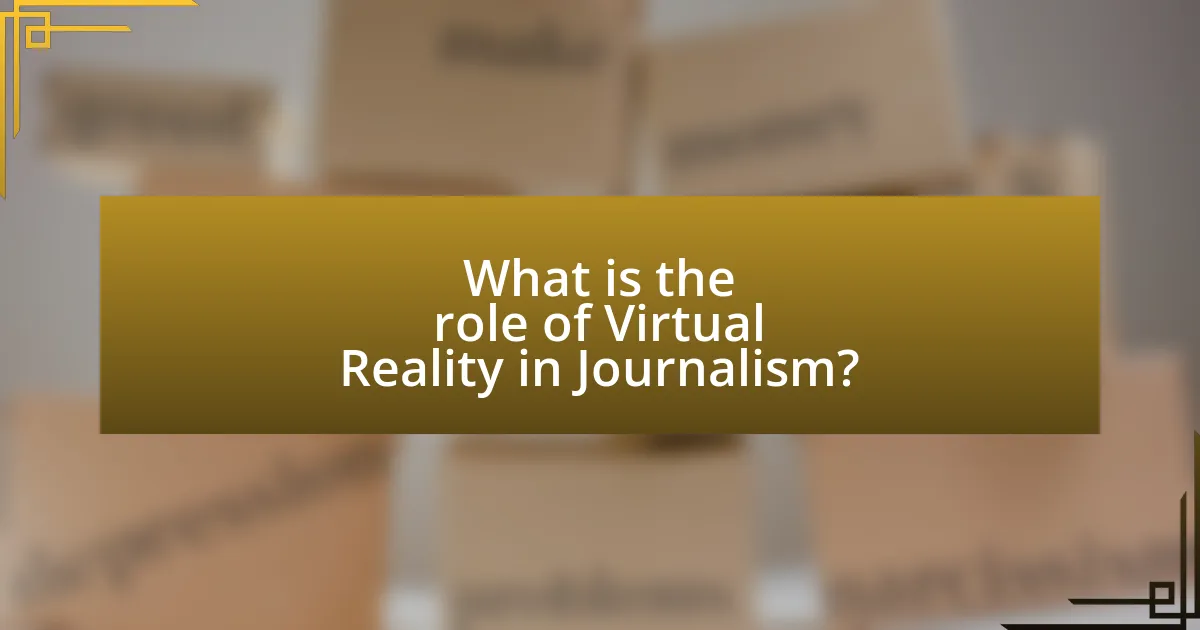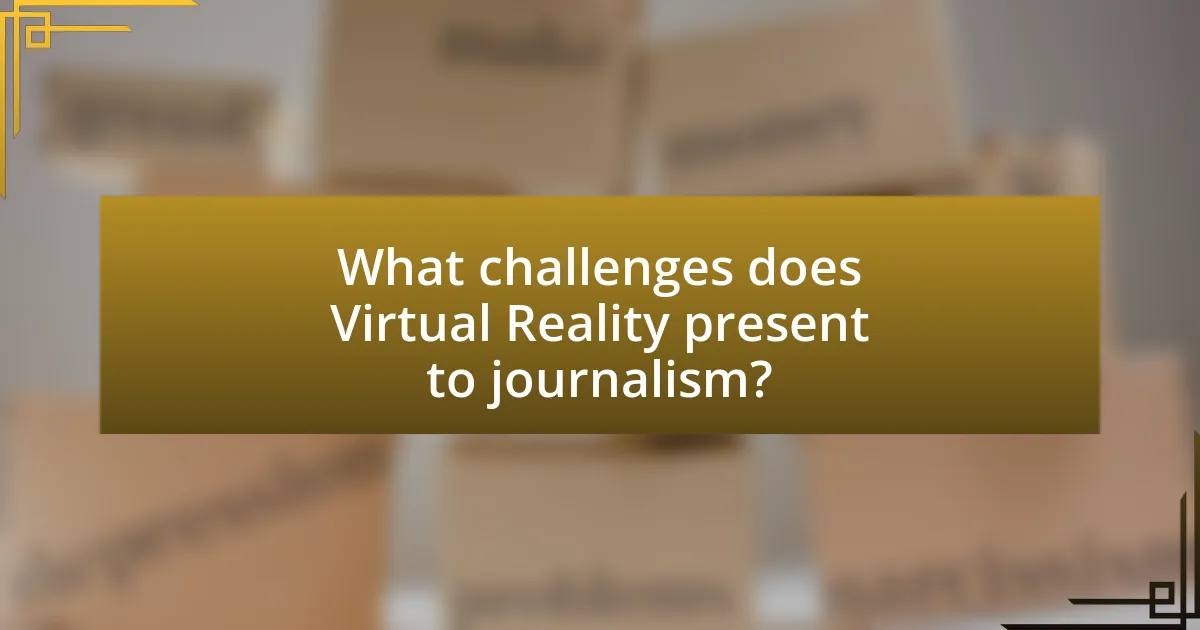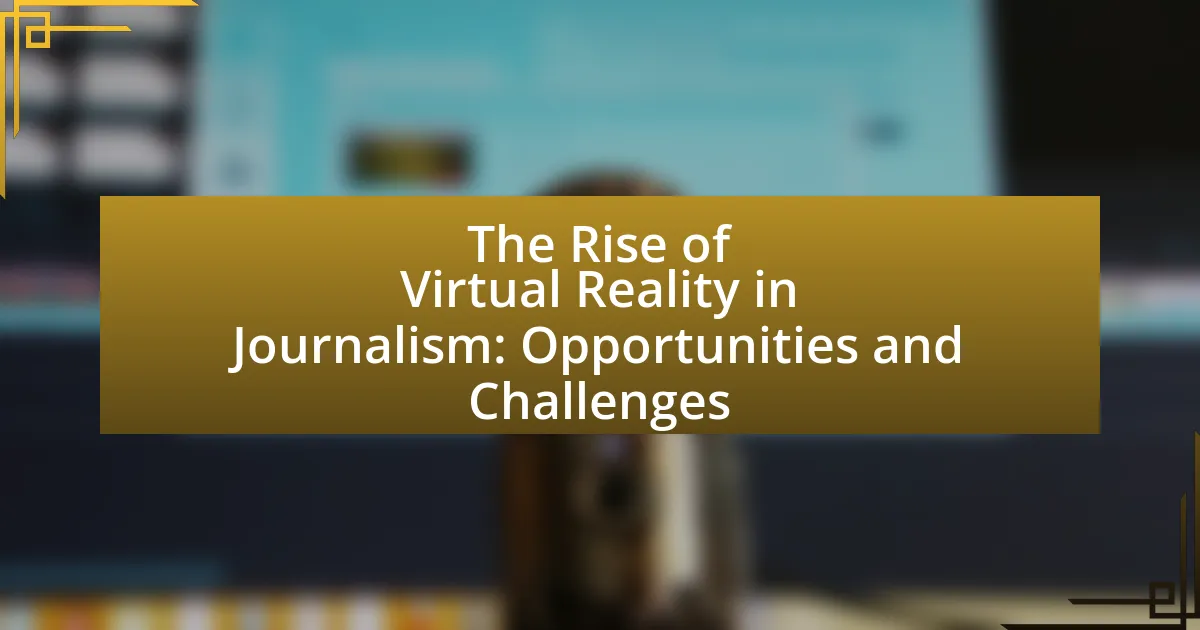The article examines the transformative role of Virtual Reality (VR) in journalism, highlighting its potential to enhance storytelling through immersive experiences that foster emotional connections and empathy among audiences. It discusses how VR is reshaping traditional journalism by enabling interactive and engaging narratives, as seen in projects like “The Displaced,” which illustrates the lives of refugees. The article also addresses the key features of VR that improve audience engagement, the challenges and ethical considerations associated with its use, and the future trends that may shape VR journalism, including advancements in technology and the importance of audience feedback.

What is the role of Virtual Reality in Journalism?
Virtual Reality (VR) plays a transformative role in journalism by enhancing storytelling through immersive experiences. By allowing audiences to engage with news content in a three-dimensional space, VR provides a deeper emotional connection to the stories being told. For instance, VR has been utilized in reporting on humanitarian crises, enabling viewers to virtually experience environments affected by conflict or disaster, which can lead to increased empathy and understanding. A notable example is the New York Times’ “The Displaced,” which used VR to showcase the lives of children displaced by war, illustrating how immersive technology can elevate traditional reporting methods and foster a more profound public discourse on critical issues.
How is Virtual Reality transforming traditional journalism?
Virtual Reality (VR) is transforming traditional journalism by enabling immersive storytelling that enhances audience engagement and understanding. This technology allows journalists to create 360-degree experiences that place viewers in the midst of news events, fostering a deeper emotional connection to the stories being told. For instance, VR has been used in projects like “The Displaced,” which follows the lives of refugees, allowing users to experience their challenges firsthand. Research indicates that immersive experiences can increase empathy and retention of information, making VR a powerful tool for conveying complex narratives in journalism.
What are the key features of Virtual Reality that enhance storytelling?
The key features of Virtual Reality that enhance storytelling include immersive environments, interactivity, and emotional engagement. Immersive environments allow users to experience narratives in a 360-degree space, making them feel as though they are part of the story. Interactivity enables users to make choices that influence the narrative, creating a personalized experience. Emotional engagement is heightened through realistic simulations and sensory experiences, which can evoke strong feelings and connections to the story. Research indicates that these features significantly improve audience retention and empathy, as evidenced by studies showing that VR experiences can lead to a 30% increase in emotional responses compared to traditional media.
How does Virtual Reality engage audiences differently than traditional media?
Virtual Reality (VR) engages audiences differently than traditional media by providing immersive experiences that allow users to interact with content in a three-dimensional space. Unlike traditional media, which typically presents information in a linear format, VR enables users to explore environments and narratives actively, fostering a sense of presence and emotional connection. Research indicates that immersive storytelling in VR can enhance empathy and retention of information, as users feel like participants rather than passive observers. For example, a study by the University of Southern California found that participants who experienced news stories in VR reported higher levels of emotional engagement and understanding compared to those who consumed the same stories through text or video formats. This unique engagement model positions VR as a powerful tool in journalism, offering opportunities to convey complex narratives in a more impactful way.
What are the potential benefits of using Virtual Reality in journalism?
The potential benefits of using Virtual Reality in journalism include enhanced storytelling, immersive experiences, and increased audience engagement. Virtual Reality allows journalists to create narratives that place viewers directly in the environment of the story, fostering a deeper emotional connection. For instance, a study by the University of Southern California found that VR experiences can increase empathy levels in viewers, making them more likely to understand and relate to the subjects being reported on. Additionally, VR can provide unique perspectives on events, allowing audiences to experience situations from different angles, which traditional media cannot offer. This innovative approach can lead to higher retention of information and a more impactful understanding of complex issues.
How can Virtual Reality improve audience understanding of complex issues?
Virtual Reality (VR) can significantly enhance audience understanding of complex issues by providing immersive experiences that allow users to engage with content in a more interactive and personal manner. This technology enables audiences to visualize and experience scenarios that are difficult to comprehend through traditional media, such as news articles or videos. For instance, a VR simulation of climate change effects can allow users to witness rising sea levels or extreme weather events firsthand, fostering a deeper emotional connection and understanding of the issue. Research by the Stanford Virtual Human Interaction Lab indicates that immersive experiences can lead to increased empathy and retention of information, making complex topics more relatable and easier to grasp.
What unique experiences does Virtual Reality offer to journalists and their audiences?
Virtual Reality offers immersive storytelling experiences that allow journalists to present news in a more engaging and impactful manner. This technology enables audiences to experience events as if they are physically present, fostering a deeper emotional connection to the story. For instance, a VR documentary on climate change can transport viewers to affected areas, making the consequences more tangible and urgent. Research by the Stanford Virtual Human Interaction Lab indicates that immersive experiences can significantly enhance empathy and understanding, demonstrating that VR can effectively convey complex narratives and foster a more informed public.

What challenges does Virtual Reality present to journalism?
Virtual Reality presents several challenges to journalism, including high production costs, the need for specialized skills, and potential ethical concerns. High production costs arise from the advanced technology and equipment required to create immersive VR content, which can limit accessibility for smaller news organizations. The need for specialized skills is evident as journalists must learn new techniques for storytelling and audience engagement in a 3D environment, which can be a barrier to entry. Ethical concerns include issues related to representation, consent, and the potential for misinformation, as immersive experiences can manipulate perceptions and emotions more profoundly than traditional media. These challenges necessitate careful consideration and adaptation within the journalism industry to effectively leverage VR technology.
What are the technical limitations of Virtual Reality in journalism?
The technical limitations of Virtual Reality in journalism include high costs, limited accessibility, and hardware constraints. High costs arise from the need for advanced equipment and software, which can be prohibitive for many news organizations. Limited accessibility is evident as not all audiences have access to VR headsets or the necessary technology to experience VR content, leading to a smaller reach compared to traditional media. Hardware constraints also pose challenges, as VR experiences often require powerful computers or devices, which can limit the production and distribution of VR journalism. According to a report by the Pew Research Center, only 15% of Americans own a VR headset, highlighting the accessibility issue.
How do hardware and software requirements affect the adoption of Virtual Reality?
Hardware and software requirements significantly impact the adoption of Virtual Reality (VR) by determining the accessibility and usability of VR systems. High-performance hardware, such as powerful graphics processing units (GPUs) and sufficient memory, is essential for rendering immersive environments, while software compatibility ensures that applications can run effectively on various devices. For instance, a study by the International Data Corporation (IDC) in 2021 indicated that 70% of potential VR users cited hardware limitations as a barrier to entry, highlighting the importance of affordable and efficient technology in promoting widespread adoption. Additionally, software development frameworks that support cross-platform functionality can enhance user experience and broaden the market reach, further influencing the rate of VR adoption in fields like journalism.
What are the challenges in creating high-quality Virtual Reality content?
Creating high-quality Virtual Reality content faces several challenges, including technical limitations, high production costs, and user experience issues. Technical limitations arise from the need for advanced hardware and software to render immersive environments, which can restrict accessibility. High production costs are driven by the requirement for specialized skills and equipment, making it financially challenging for many creators. User experience issues include motion sickness and the need for intuitive interfaces, which can hinder audience engagement. These challenges are supported by industry reports indicating that 70% of VR developers cite technical hurdles as a significant barrier to content creation.
What ethical considerations arise with the use of Virtual Reality in journalism?
The ethical considerations that arise with the use of Virtual Reality in journalism include issues of consent, representation, and the potential for misinformation. Journalists must ensure that participants in VR experiences provide informed consent, understanding how their likeness and stories will be used. Additionally, the immersive nature of VR can lead to biased representations, as the technology may prioritize certain narratives over others, potentially misrepresenting the reality of events. Furthermore, the ability to manipulate VR environments raises concerns about the accuracy of the information presented, as altered or fabricated scenarios could mislead audiences. These ethical challenges necessitate careful consideration and adherence to journalistic standards to maintain credibility and trust.
How can journalists ensure accuracy and authenticity in Virtual Reality reporting?
Journalists can ensure accuracy and authenticity in Virtual Reality reporting by implementing rigorous fact-checking processes and utilizing reliable sources. This involves cross-referencing information with multiple credible outlets and experts in the field to verify the content presented in the VR experience. For instance, a study by the Tow Center for Digital Journalism highlights that immersive storytelling requires a commitment to journalistic standards, emphasizing the importance of transparency about the sources and methods used in creating VR content. By adhering to these practices, journalists can maintain the integrity of their reporting in the evolving landscape of Virtual Reality.
What are the implications of immersive experiences on audience perception?
Immersive experiences significantly enhance audience perception by creating a deeper emotional connection and fostering empathy. Research indicates that when audiences engage with immersive content, such as virtual reality journalism, they are more likely to experience heightened emotional responses, which can lead to a greater understanding of complex issues. For instance, a study published in the journal “Virtual Reality” by authors Bailenson et al. (2008) demonstrated that participants who experienced a virtual environment depicting social issues reported increased empathy and a stronger intention to take action compared to those who consumed traditional media formats. This suggests that immersive experiences can transform audience perception by making narratives more impactful and relatable.

How can journalists effectively integrate Virtual Reality into their work?
Journalists can effectively integrate Virtual Reality (VR) into their work by creating immersive storytelling experiences that engage audiences on a deeper emotional level. By utilizing VR technology, journalists can transport viewers to the scene of events, allowing them to experience stories firsthand, which enhances understanding and empathy. For instance, projects like “The Displaced,” produced by The New York Times, showcase how VR can depict the lives of refugees, providing a powerful narrative that traditional media cannot achieve. This approach not only captures attention but also fosters a more profound connection with the subject matter, as evidenced by studies indicating that immersive experiences can increase viewer retention and emotional response.
What best practices should journalists follow when using Virtual Reality?
Journalists should prioritize audience immersion and ethical storytelling when using Virtual Reality (VR). Immersive experiences can enhance emotional engagement, making it crucial for journalists to create content that allows users to feel present in the story. Ethical storytelling involves accurately representing subjects and contexts, ensuring that VR experiences do not mislead or exploit vulnerable populations. For instance, the use of VR in reporting on humanitarian crises must be handled sensitively to avoid desensitization or voyeurism. Additionally, journalists should consider accessibility, ensuring that VR content is available to diverse audiences, including those with disabilities. Following these best practices can lead to more impactful and responsible journalism in the VR space.
How can journalists balance creativity and factual reporting in Virtual Reality?
Journalists can balance creativity and factual reporting in Virtual Reality by integrating immersive storytelling techniques with rigorous fact-checking processes. This approach allows journalists to engage audiences emotionally while ensuring that the information presented is accurate and reliable. For instance, the use of 360-degree video can enhance the narrative experience, but it must be accompanied by verified data and sources to maintain journalistic integrity. Research indicates that immersive experiences can significantly impact audience perception, making it crucial for journalists to uphold factual accuracy even in creative formats.
What tools and resources are available for journalists to create Virtual Reality content?
Journalists can utilize various tools and resources to create Virtual Reality (VR) content, including software like Unity and Unreal Engine for development, and hardware such as Oculus Rift and HTC Vive for immersive experiences. Additionally, platforms like YouTube and Facebook support 360-degree video uploads, enabling wider distribution of VR content. According to a report by the International Journal of Journalism, these tools facilitate storytelling by allowing audiences to engage with narratives in a more immersive manner, enhancing the overall impact of journalistic work.
What future trends can we expect in Virtual Reality journalism?
Future trends in Virtual Reality journalism include increased interactivity, enhanced storytelling techniques, and broader accessibility through mobile platforms. Interactivity will allow audiences to engage with content in immersive ways, such as choosing their perspective within a story, which can lead to deeper emotional connections. Enhanced storytelling techniques will leverage 360-degree video and spatial audio to create more compelling narratives, making the news experience more engaging. Additionally, as mobile VR technology becomes more prevalent, journalists will be able to reach wider audiences, democratizing access to immersive news experiences. According to a report by the Pew Research Center, 59% of journalists believe that VR will play a significant role in the future of news, indicating a strong industry trend towards adopting this technology.
How might advancements in technology shape the future of Virtual Reality in journalism?
Advancements in technology will significantly enhance the future of Virtual Reality (VR) in journalism by improving immersion, interactivity, and accessibility. Enhanced hardware, such as more powerful processors and higher-resolution displays, will allow journalists to create more realistic and engaging VR experiences that can transport users to the scene of events, fostering a deeper emotional connection to the stories being told. For instance, the development of 5G networks will enable faster data transmission, allowing for real-time streaming of high-quality VR content, which can be crucial for live reporting. Additionally, advancements in artificial intelligence can facilitate personalized content delivery, tailoring VR experiences to individual user preferences and enhancing engagement. These technological improvements are supported by industry trends, such as the increasing investment in VR technologies by major media companies, indicating a strong belief in the potential of VR to transform storytelling in journalism.
What role will audience feedback play in the evolution of Virtual Reality journalism?
Audience feedback will play a crucial role in the evolution of Virtual Reality journalism by shaping content creation and enhancing user engagement. As VR journalism develops, audience insights will inform journalists about viewer preferences, leading to more tailored and impactful storytelling. For instance, studies indicate that immersive experiences in VR can significantly increase emotional engagement, suggesting that feedback on emotional responses can guide content creators in refining their narratives. Furthermore, platforms that incorporate audience feedback mechanisms, such as surveys or interactive elements, can adapt in real-time, ensuring that the journalism remains relevant and resonates with viewers. This iterative process of feedback and adaptation will ultimately drive innovation and improve the quality of VR journalism.
What practical tips can journalists use to get started with Virtual Reality?
Journalists can get started with Virtual Reality by familiarizing themselves with VR technology and tools, such as 360-degree cameras and VR editing software. Understanding the basics of VR production is crucial, as it allows journalists to create immersive content that engages audiences effectively. Additionally, they should experiment with storytelling techniques specific to VR, which often require a different approach than traditional media. For instance, journalists can explore spatial storytelling, where the environment plays a significant role in the narrative. Engaging with existing VR journalism projects can provide insights into best practices and innovative ideas. Furthermore, attending workshops or online courses focused on VR in journalism can enhance their skills and knowledge in this emerging field.

Leave a Reply